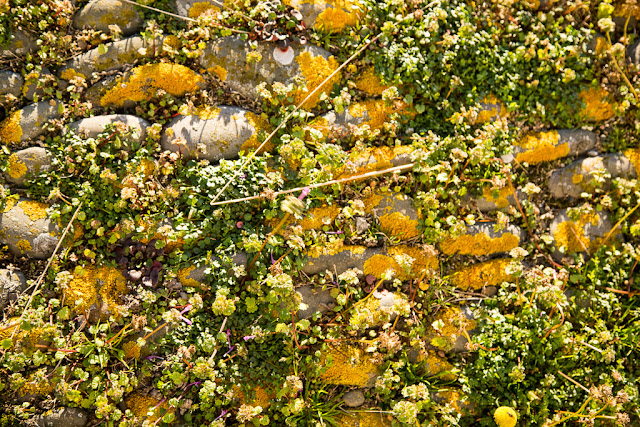The Kirkcudbright yacht marina has some long pontoons which run parallel with the channel of the River Dee. If you want to progress upstream take the outside as the access pontoon blocks the inner passage. In case you have just joined the story in this blog, I should clarify that this is the Galloway River Dee. There are four River Dees in Britain: this one, one in Aberdeenshire, one in Cumbria and one in Wales. The Kirkcudbright Dee rises in the Galloway Hills in the catchment area of Cairsnmore of Carsphairn and Cairnsmore of Dee. There is an old Galloway saying:
There is Cairnsmore of Carsphairn and Cairnsmore of Dee,
but Cairnsmore of Fleet is highest of all three.
Having set off from the estuary of the River Fleet and now entered the estuary of the River Dee, our kayaks had been wetted by the run off from the watersheds of three fine Galloway mountains.
We arrived at Kirkcudbright harbour to find the fishing fleet getting ready to leave at high water. The slipway can be seen just to the right of the yacht. I have...
...used it successfully on previous occasions, such as this one with Tony in July 2013. However, when Ian, Mike and I arrived, it was covered with desperately slippy mud. Ian and I both tried to climb up it but it simply was not possible as it had a coefficient of friction, which was substantially less than a well known buttered substance.
You need to be careful leaving cars and kayaks in Kirkcudbright. A big spring tide comes over the top of the quay!
We retreated a little downstream to near the access pontoon for the marina. We changed out of our dry suits into attire suitable for dinner. Then I tied the boats to a tree with my tow line because...see above!
Kirkcudbright (Kir-coo-bri) is a delightful former county town with wide streets and gaily painted walls. It is named after St Cuthbert who was a seventh century monk of the Celtic church who was based in Northumberland. The town has been a Royal Burgh since 1453 and as such it became the county town for Kirkcudbrightshire one of the old Scottish counties. In 1960 its court house was the scene of the trial of the lighthouse man who murdered the keeper of Little Ross lighthouse which we had explored that morning.
In the early 20th century Kirkcudbright attracted many authors and artists. Those who stayed here include Dorothy L Sayers, E A Hornel, Jessie M King, E A Taylor, S J Peploe and Charles Oppenheimer.
Kirkcudbright Castle occupies a central position at the corner of Castle Street and is more commonly known as Maclellan's Castle as it was built in 1582 by Sir Thomas Maclellan, the Provost of Kirkcudbright. It was built as a fortified town house rather than as a serious castle, which could have withstood a siege. It has been a ruin since 1752.
We walked through the streets until we came to some cobbles in the road outside the Selkirk Arms Hotel. These inconspicuous signs mark the site of the 15th century "Meickle Yett" which was the gate through the town's defensive wall. This was built to keep English pirates and trouble makers out of the town. As the town grew the Yett was moved in 1780 to the nearby church yard where it still stands today.
Anyway enough preamble we had come to Kirkcudbright to visit the Selkirk Arms Hotel. We were in good company, the poet Robert Burns stayed here in 1749 when he was working as a customs officer in the area. It was here (and not in the town of Selkirk) that he wrote the Selkirk Grace:
Some hae meat and canna eat,
And some wad eat that want it;
But we hae meat, and we can eat,
Sae let the Lord be thankit.
It was also known as the Galloway Grace.
Anyway I dragged Ian and Mike inside where it was quickly apparent to them that we had entered a hostelry of some considerable worth. Although draught Guinness was available, we decided to break with tradition and enjoyed draught Peroni instead.
When it comes to food the Selkirk Arms hotel prides itself on using local producers and suppliers. Mike and I shared Alan Watson's Galloway Smokehouse board while Ian had a local goat's cheese salad. But this was just for starters we each followed up with hot Galloway beef with roasted tomato and rocket served in a sour dough roll which was simply scrumptious. Note the blackboard which gives the provenance of the steak as Todd Hill Muir farm, in nearby Lockerbie which had been butchered at Carsons in even nearer Dalbeattie. There are no Airmiles for the food served here. If it had been in season, I would have ordered....
...local lobster, which I have enjoyed here on many previous occasions.
I asked the waitress to let the chef know that three hungry sea kayakers had arrived. Within seconds, part owner, chef and fellow sea kayaker, Chris Walker, appeared in his whites for a chat for a chat. We shared tales of camping on Little Ross and of rough conditions in the Little Ross tiderace before Chris had to dash off to cook the next order. A very posh sounding lady guest could be heard asking the waitress why the chef had spoken to "them" and not to her. We had noticed she had moved from the table next to us earlier in our meal...I can't imagine why!
At 500m from the sea (at high tide) the Selkirk Arms is at the upper distance of what is normally considered as acceptable to be considered as a sea kayaking pub. However, the welcome, the exceptional food, ambience and service mean that this is this is a sea kayaking par excellence. On a score out of 10 Ian and I are unanimous in awarding it 13/10!



















































